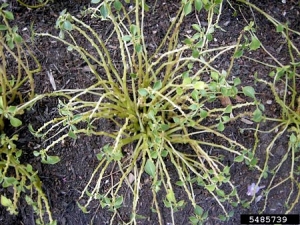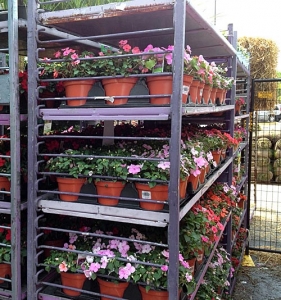Impatient For Impatiens?
Be wary of mildew
By Gil Medeiros, Fairfax Master Gardener Intern
In the summer of 2012, local gardeners made a stunning discovery. The impatiens they had planted in late spring had suddenly turned into groups of spindly, bare stalks – seemingly overnight. Gardeners scrambled to garden centers, called the local extension office, or flocked to plant clinics to find out why and learned that the plants had been afflicted with a disease known as Impatiens Downy Mildew (IDM).

Impatiens walleriana with IDM
People working in the nursery trade were already familiar with IDM, which they thought had been isolated to greenhouses. But somehow between 2011 and 2012, the disease broke loose and spread rapidly up the East Coast, its spores either riding the southerly winds or transported on infected nursery stock. As the fungus-like organism infected plants, it produced new spores that spread to adjacent plants, and more spores were released to the winds.
Gardeners learned that Impatiens walleriana, those long blooming, shade-loving beauties, were particularly susceptible to this disease, and that, once infected, a plant could not be saved. The news got worse; the spores were thought to live in the ground for years. Gardeners were advised not to plant more impatiens where their plants had suffered sudden decline and death. And so began the search for replacements: the nursery trade increased its production of Begonias, Torenias, and Coleus to fill the void left by impatiens.
In 2013 and 2014, major garden centers posted signs indicating they would not carry Impatiens walleriana because of IDM. But impatiens did not completely disappear. Some plant shops, usually small ones, still maintained limited supplies for brave gardeners willing to accept the risk and perhaps douse their plants regularly with fungicide.
Now, in 2015, a major big-box store in Fairfax County is carrying Impatiens walleriana in large quantities. Has the risk somehow been reduced?

Racks of Impatiens walleriana await customers at Fairfax County big-box store
A lingering menace
Local experts in business and government advise gardeners to stay cautious when considering whether to plant impatiens.
Fairfax County Extension Agent Adria Bordas, one of the top plant pathologists in Virginia, says, “I think Impatiens Downy Mildew will be a challenge in our landscapes, especially for those who had the disease in the past. The spores will survive in the leaf litter and on alternate weed hosts.”
Merrifield Garden Center will not be selling Impatiens walleriana in its stores this season, says David Yost, host of “Merrifield’s Gardening Advisor,” Merrifield Garden Center’s long-running cable TV program. “We feel that IDM poses a significant risk of infecting the plants which leads to disappointment for our customers, losses for our business, and perpetuates the disease,” he says. “Another consideration in this decision is that there are many other wonderful alternatives to I. walleriana that are not susceptible to this disease. Begonias, Torenia, Coleus, New Guinea Impatiens and many others can be used to provide the color we all want in shady locations of our gardens.”
In the meantime, Yost says, Merrifield Garden Center continues “to watch for any developments such as disease resistant varieties or changes in management strategies that will allow us to resume selling impatiens and hope we will see them in our stores again.”
Meadows Farms Nurseries takes a slightly more optimistic position. The Meadows Farms website contains this notice:
| Impatiens Downy Mildew (IDM)
The disease that affected bedding plant impatiens and limited their availability in 2013 and 2014 could still be present. Although evidence of the disease last spring was minor, it is believed the parasitic microbe that causes the disease could still be living in the soil. If you suspect you had bedding plant impatiens die from this disease, it is recommended that you do not plant bedding plant impatiens in the same spot. New Guinea, SunPatiens and Bounce Impatiens varieties are NOT affected by IDM. The availability from our growers will be limited this season until there is a clear decision on the fate of bedding plant impatiens (Impatiens walleriana). One explanation for the low incidence of IDM last spring is that so little Impatiens walleriana was planted. |
Fairfax Gardening asked Bell Nurseries, plant supplier to a major big box chain, to comment. At press time, they had not responded.
Hope on the horizon?
New methods of handling plants in production greenhouses may provide some hope. The Extension Service at Michigan State University claims to have had success in preventing IDM by using a combination of fungicides, some of them new, on nursery seedlings grown for sale. Their results show that, under some weather conditions, this fungicide treatment can extend protection to impatiens planted in Michigan gardens for an entire season. However, Michigan is not Virginia, where summer humidity and resulting disease pressure is high.
Since the market for Impatiens walleriana before IDM was huge, plant breeders are hard at work to find new cultivated varieties that are resistant to IDM. Ball Horticultural, one of the largest plant breeders in the world, has developed a new variety called Bounce Impatiens (Impatiens hybrida). Selecta, a Ball subsidiary, is selling its seeds to nurseries in 2015. Selecta claims that Bounce Impatiens

‘Big Bounce Lilac’ – Selecta Seeds introduced Bounce Impatiens in 2014
- Are resistant to IDM
- Recover quickly from severe wilting due to lack of water
- Come in a wide variety of colors
- Need about three hours of sunlight per day
Burpee Seeds, another Ball subsidiary, does not yet offer the seeds to retail customers. However, plant wholesale giant Monrovia has carried limited numbers of these plants in 2015.
Are these IDM-resistant varieties the answer? Not quite. Bounce Impatiens, with their three-hour-a-day sun requirement, are not a direct replacement for Impatiens walleriana, which thrive in full shade.
What to do this year
Experts say you should plant something other than impatiens in shady locations until reliable hybrids or treatment methods have been vetted. If you decide to plant Impatiens before then, the Virginia Cooperative Extension advises
- Do not plant Impatiens walleriana in a bed where IDM has occurred in the past.
- Avoid overhead watering, particularly in the afternoon or evening.
- At the first sign of IDM (gray, fuzzy growth on the underside of leaves), remove the entire plant immediately and dispose of it in a plastic bag in domestic trash. Do not compost it.
References
Impatiens Downy Mildew, Virginia Cooperative Extension Publication PPWS-19NP, 2013
Crop Culture Report: Bounce Interspecific Impatiens, Greenhouse Product News, June 9, 2014
Impatiens Are Back in Michigan Gardens, Detroit Free Press, May 14, 2015